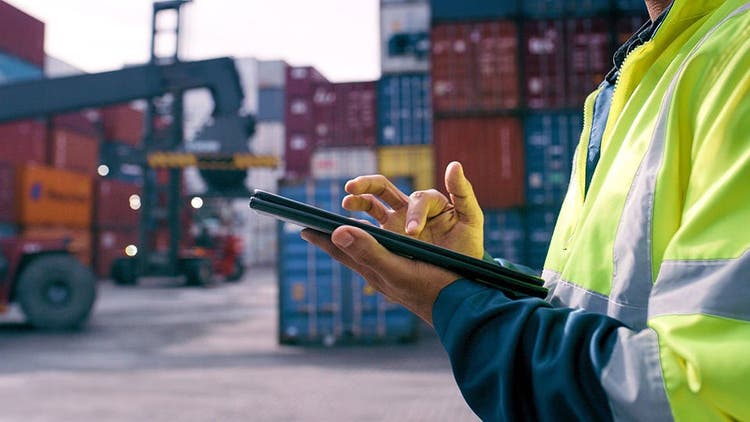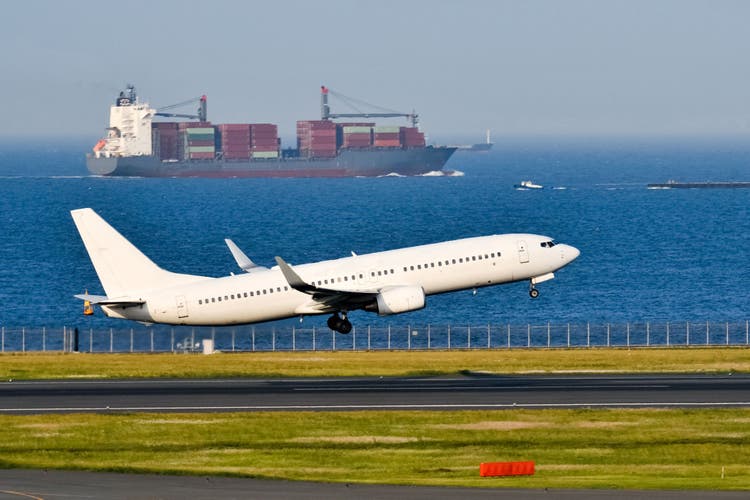Freight and Logistics News and Market Update
Week of October 15, 2025
Top Takeaways
Global supply chains face pressure as US shutdown disrupts logistics, China enacts retaliatory port fees and European port strikes deepen; US import volumes expected to remain weak through year-end
- The US government shutdown, now in its third week, is straining logistics networks. Staffing shortages among air traffic controllers are causing congestion at major hubs, while shipments requiring clearance from other agencies face growing delays.
- China has introduced new port fees on US-owned, operated or controlled vessels beginning October 14, mirroring recent US measures on Chinese ships.
- Strikes at Rotterdam and Antwerp, two of Europe’s busiest ports, are intensifying congestion and disrupting vessel movements across Northern Europe, adding to weather-related delays and further straining the Asia–Europe trade.
Regions
Air
- The US government shutdown began on October 1 and has entered its third week with no resolution in sight. Staffing shortages among air traffic controllers have caused congestion and delays across major US hubs. Customs and Border Protection remains operational, though shipments requiring clearance from other agencies may face delays. As the shutdown continues, further disruptions to supply chain operations are increasingly likely.
- Air freight rates from China to the US have risen in recent weeks as the postponed tariff deadline nears and new disputes over rare earth minerals intensify. Spot rates have reached $5 per kilogram, marking their highest level in two months. Imports from the wider APAC region to the US continue to grow, especially in the tech sector, though the strongest gains are coming from alternative Asian markets as Chinese tech exports to the US decline year-over-year.
Ocean
- China began imposing new port fees on US-owned, operated or controlled vessels on October 14 in response to similar US measures targeting Chinese ships. The fees start at about $56 per net ton and rise annually to $157 by 2028. They apply to US-built, US-flagged or majority US-owned vessels, as well as those with more than 25% US ownership. Carriers likely to be affected include Matson, Maersk, APL and possibly Seaspan, though Matson said it will not pass the added costs to customers.
- Indian reefer exports to the US have dropped 30% to 50% as steep US tariffs on seafood, frozen foods and pharmaceuticals make trade less viable. Rates from Nhava Sheva to New York have fallen to about $3,000 to $3,200 per FEU as carriers cut capacity to stabilize prices. Although seafood shipments have been hit hardest, pharmaceutical exports remain steady for now. Ocean Network Express has launched a new reefer rail link from Hyderabad to Nhava Sheva to support pharma trade as carriers adapt to shifting market conditions.
- The US has warned it will impose sanctions on countries supporting the International Maritime Organization’s net-zero framework, which would require ships to cut emissions by 17% by 2028 or pay a compliance fee. Washington argues the plan amounts to a global carbon tax on American consumers and says it may impose visa restrictions, additional port fees and trade penalties in response. The threat comes ahead of the Oct. 14 to 17 IMO meeting in London, where approval will depend on backing from countries representing at least half of global vessel tonnage, including flag states such as Liberia, Panama and the Marshall Islands.
- Falling US imports are tightening truckload capacity in several inland markets, pushing up spot rates as the fall shipping season begins. With fewer containers arriving from Asia, trucks have fewer return loads to ports, driving rate surges on lanes between Los Angeles, Las Vegas and Stockton. The average US dry-van spot rate rose to $1.70 per mile in early October, with Midwest markets averaging $1.92. Analysts say these imbalances could keep rates higher through the fourth quarter, even as import volumes stay below 2 million TEUs in the months ahead.
- US import volumes are projected to remain below 2 million TEUs per month through late 2025 as retailers front-loaded shipments ahead of new tariffs. Forecasts show double-digit year-over-year declines from October to December, with October at 1.97 million TEUs, down 12.3%, November at 1.75 million, down 19.2% and December at 1.72 million, down 19.4%. Total imports for 2025 are expected to reach 24.79 million TEUs, about 3% lower than 2024 as weaker consumer demand, inflation and trade uncertainty weigh on volumes. Early 2026 projections also point to continued softness.
Air
- Abra Group, the strategic investor behind Avianca and Gol, has applied for authorization from Chile’s civil aviation authority to launch NG Servicios Aéreos, a Santiago-based airline focused on non-scheduled charter and ACMI operations. The carrier, fully owned by Abra Group, will support its existing airlines and other operators across South America to provide operational flexibility and cost efficiency depending on market demand. NG Servicios Aéreos is authorized to transport passengers, cargo and mail domestically and internationally and recently appeared operating a Boeing 737-800 with Chilean registration CC-DNU under Gol’s colors.
- The Latin America to Europe air freight market has shown steady growth, supported by resilient trade flows and growing interest from regional and international carriers. Avianca Cargo has expanded its network with new freighter services connecting Quito, Miami, Maastricht and Zaragoza, strengthening links to both Europe and China. Exports from Latin America to the EU remain stable for high value and perishable goods, while capacity on the return leg is more volatile. Brussels Airport now operates 15 weekly rotations to 13 Latin American destinations, up from four in March 2024. Rates between the regions have stabilized after early year peaks but limited freighter capacity and infrastructure challenges continue to constrain growth.
Ocean
- Panama Canal traffic increased 19.25% in the last fiscal year despite higher US tariffs and global trade tensions. Between October 2024 and September 2025, 13,404 vessels carrying 489 million tons of cargo passed through the canal, linking ports in China, Japan and South Korea with the US East Coast. Although growth was strong, it fell short of projections by the canal authority, which expects the impact of US tariffs to be felt more fully in the next fiscal year.
- DP World has renewed its ten-year partnership with Hapag-Lloyd at Brazil’s Port of Santos, ensuring continued container handling and long-term service stability. The agreement supports DP World’s terminal expansion, which will extend the quay to 1,290 meters and increase capacity to 1.7 million TEUs by 2026, enabling larger vessel operations. Beyond port upgrades, DP World is expanding its logistics network across Brazil through new freight forwarding offices, rail partnerships and IATA-certified air freight services. The company handled a record 1.25 million TEUs in 2024, up 14% year-over-year, underscoring both partners’ commitment to strengthening Brazil’s trade connectivity.
- Severe rainfall in October 2025 caused deadly landslides and flooding across Veracruz, Puebla, Hidalgo, Queretaro, San Luis Potosi and Chiapas, leaving more than 150,000 residents without power. Government reports confirm at least 44 fatalities linked to tropical storms Priscilla and Raymond, which brought several days of heavy rain. The extreme weather disrupted cargo transport throughout the affected regions, and operations at the Port of Veracruz are expected to face delays.
Air
- Asia Pacific airlines recorded a 5.4% year-over-year increase in international air freight demand in August 2025, driven by eCommerce growth and stockpiling linked to tariff-related price pressures. Despite a slight decline in freight load factor to 59.5%, freight capacity expanded 5.5%, highlighting the continued resilience of regional cargo markets.
- Global air cargo tonnages rose 4% year-over-year in the third quarter of 2025, led by a 7% increase from the Asia Pacific region. Intra-Asia Pacific flows climbed 10%, reinforcing the region’s strength in international air freight trade. Average global rates were 3% lower than a year ago, reflecting steadier pricing conditions across major markets. However, super-typhoon Ragasa disrupted operations in late September, with cargo volumes from Hong Kong and China dropping sharply ahead of China’s extended Golden Week holiday, further straining global supply chains.
- Air freight capacity across Asia Pacific remains tight in October amid peak-season demand, typhoon disruptions and factory closures during China’s Golden Week. Rising exports of semiconductors, AI components and electronics from Southeast Asia—particularly Thailand, Vietnam, Malaysia and Singapore—are fueling demand, while major transit hubs in Singapore, Taiwan, Hong Kong and South Korea face congestion and higher rates. Shippers are advised to plan early and diversify logistics strategies to minimize delays and manage rising costs.
- Singapore’s Changi Airport is realigning its air cargo strategy to focus on high-value sectors such as pharmaceuticals, perishables and cross-border eCommerce, backed by advanced cold chain systems and express logistics capabilities. The move reflects a wider Asia Pacific trend where regional hubs are emphasizing precision handling and supply chain resilience over total cargo volume.
Ocean
- Eastbound trans-Pacific container rates dropped 15% last week to $1,853 per FEU on the Freightos Baltic Index, as weak demand and tariff uncertainty weigh on volumes. Limited frontloading ahead of China’s Golden Week failed to lift rates, prompting carriers to cancel sailings and prepare for continued softness through the end of the year.
- Cosco and OOCL plan to maintain service levels without adding surcharges despite upcoming US port fees on Chinese-operated vessels, signaling confidence that the costs—estimated at up to $2.1 billion by 2026—can be absorbed, possibly through state support. Trans-Pacific container rates have continued to fall after Golden Week, with Asia–US West Coast prices down 16% to $1,554 per FEU amid growing capacity and trade tension.
Air
- European carriers recorded a 3.2% year-over-year increase in demand in August, driven by strong Europe–Asia trade flows and a 5.1% rise in international operations. Capacity expanded 4.2%, keeping conditions stable with a 49.2% load factor. While growth varied across routes, Europe continues to show steady resilience as global trade patterns evolve.
Ocean
-
The Drewry World Container Index fell 1% to $1,651 per 40-ft container as of October 9, its 17th straight weekly decline and the lowest level since January 2024. Rates from Shanghai to Los Angeles slipped to $2,176 and to Rotterdam to $1,577, reflecting soft demand following Golden Week and continued weakness in the global supply-demand balance.
-
Strikes at the ports of Rotterdam and Antwerp are compounding congestion and slowing container handling across Northern Europe. Limited pilotage in Belgium and a two-day strike by lashing workers in Rotterdam have halted vessel movements and inland transport, worsening delays from last week’s storms. The disruptions are weighing further on the Asia–Europe trade, where schedule reliability remains low at 23%. Even even top-performing alliances like Gemini are showing signs of strain from ongoing capacity and transit challenges.
Air
-
Royal Air Maroc Cargo has partnered with CargoAi to digitalize and streamline its cargo operations across Africa, Europe and other global markets. Through CargoAi’s CargoMART platform and integrations with leading Transport Management Systems, more than 23,000 freight forwarders can now view real-time rates and book shipments instantly. The partnership supports Royal Air Maroc Cargo’s broader digital transformation strategy, enhancing transparency, efficiency and sustainability while aligning with global efforts to modernize air freight logistics.
-
Kenya Airways Cargo (KQ Cargo) has launched its first direct air cargo service between Sharjah and Dar es Salaam, expanding its regional network to meet growing demand for reliable trade connections. The inaugural flight transported 20.9 tons of cargo, and KQ Cargo plans to add more frequencies in the coming weeks. Developed in partnership with Alkhor Air Cargo and other key stakeholders, the new route strengthens connectivity between the UAE and East Africa by reducing transit times, simplifying cargo handling and improving supply chain efficiency. The service supports regional trade growth and reinforces East Africa’s role in the global air freight market.
Ocean
- Ocean Network Express (ONE) has introduced its new Pakistan Gulf Service (PGS) aimed to enhance connectivity between Pakistan and the Middle East and designed to meet the growing demand between the two geos. The service is planned to commence on October 18, 2025, from Jebel Ali by MV GFS GENESIS 001E. The service rotation follows the below routing:
Jebel Ali – Abu Dhabi – Sohar – Karachi – Port Qasim – Sohar – Jebel Ali
Earlier this week, QTerminals Kramer Rotterdam (QTKR) and ONE has implemented a biofuel scheme using HVO100 and reduced emissions up to 500 tons of CO2 within six months. - The Mediterranean Shipping Company (MSC) and the Shipping Corporation of India (SCI) have added Portugal’s Port of Sines to the northbound rotation of their India–Pakistan (IPAK) service to strengthen trade between Europe and the Indian Subcontinent. The updated route connects Sines, Felixstowe, Rotterdam, Hamburg, Bremerhaven, Antwerp, Le Havre, London Gateway, Port Louis, Port Reunion, Colombo, Nhava Sheva, Hazira, Mundra and Karachi before returning to Sines. The addition enhances schedule flexibility, reduces transit times and positions Sines as a key Atlantic transshipment hub within MSC’s global network, reinforcing Portugal’s expanding role in trade linking Asia, Africa and Europe.
- Container freight rates on the India–Europe trade have fallen nearly 50% since early September, with quotes from Nhava Sheva to Felixstowe or Rotterdam now averaging USD $900-$1,100 per container. Carriers are cutting rates to fill available space amid deepening capacity oversupply, even as some blank sailings continue. Additional tonnage redirected from India–US routes via transshipment hubs like Tangier and Lome has added further pressure on pricing. With India’s holiday export season tapering off, forwarders expect subdued demand and continued rate volatility in the coming months.
- The Bureau of Industry and Security (BIS) has released 95 new requests to expand Section 232 tariffs to include additional derivative aluminum and steel products. Public comments on these requests are due by October 21. BIS will evaluate each request to determine if the product qualifies as a derivative article and whether its import levels pose a threat to national security or undermine the goals of the original Section 232 investigations. Decisions will be made within 60 days, followed by a public notice and, if approved, a Federal Register update to formally include the products.
- US Customs and Border Protection (CBP) has announced a reclassification of certain wireless headphones and earphones. These items, which include wireless stereo headsets with USB dongles, mobile phone earphones and wireless earbuds with microphones, will now fall under HTSUS 8518.30.20, designated for “other headphones and earphones,” which are duty-free. Previously, they were classified under HTSUS 8517.62.00, also duty-free, but intended for devices used in data transmission and reception. This change, outlined in Ruling HQ H346387, revokes and modifies previous rulings (HQ H251033 and NY N308565) and will apply to goods entered or withdrawn for consumption on or after November 24.
- The African Growth and Opportunity Act (AGOA) and Haiti’s HELP/HOPE trade preference programs expired on September 30, 2025. Imports from eligible countries are now subject to standard most-favored-nation tariffs and reciprocal duties under the International Emergency Economic Powers Act. For 25 years, AGOA provided duty-free access to the US for more than 1,800 products from 32 sub-Saharan African nations, including special provisions for textiles and apparel. Haiti’s HELP/HOPE programs similarly allowed duty-free entry for select apparel manufactured in Haiti and the Dominican Republic. While both programs have ended, there is ongoing discussion that Congress may reauthorize them, potentially with retroactive benefits before year-end.
- US Administration announced via Truth Social that starting November 1, 2025, all medium and heavy-duty trucks imported into the US will face a 25% tariff under Section 232, citing national security concerns. This move follows a previous proclamation imposing tariffs on wood products like lumber and kitchen cabinets, effective October 14. The truck tariff was initially set for October 1 but was delayed.
More Insights From UPS Supply Chain Solutions

Navigating the 2025 Global Tariffs Landscape

2025 Tariffs and Their Impact on Global Trade

Air Freight Shipping Guide: Costs, Documentation & Quotes

Get Started with an Air or Ocean Quote
On our UPS® Forwarding Hub, get and compare quotes, book shipments and track them end-to-end on one modern, easy-to-navigate dashboard.

Stay In The Know
Get expert insights into all things freight and logistics, delivered right to your inbox.